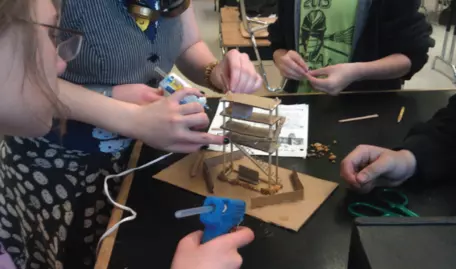Tsunami Vertical Evacuation Structures (TVES)
Summary
Students learn about tsunami vertical evacuation structures (TVES) as a viable solution for communities with high ground too far away for rapid evacuation. Students then apply basic design principles for TVES and make their own scale model that they think would fit will in their target community. Activity has great scope for both technical and creative design as well as practical application of math skills. Examples are from the Pacific Northwest, USA's most tsunami-vulnerable communities with more distant high ground, but it could be adapted to any region with similar vulnerability.
Context
Audience

Skills and concepts that students must have mastered
Learners should know what tsunami are and why and where they occur. They should be able to read and use maps. They should be able to calculate lengths needed for a scale model.
How the activity is situated in the course
Most likely this should be a culminating project of some sort. It could a project in a unit on plate tectonics and earthquakes in which learners move from just understanding the science to learning steps we can take to mitigate earthquake and tsunami risk; or it could be a major project for an engineering design unit. It has been successfully used as a major project in an after school science club too.
Goals
Content/concepts goals for this activity
Learners will be able to:
- Describe requirements of a tsunami vertical evacuation structure and why they are needed in some circumstances
Higher order thinking skills goals for this activity
- Design and build a scale model of a tsunami vertical evacuation tower or berm that fits the needs of the target community both during and not-during a tsunami
Skills goals for this activity
- Make a presentation about the design process and final model elements
- Work in a group
Description and Teaching Materials
See attached file for educator notes, NGSS alignment, and student exercise.
Tsunami Vertical Evacuation Structures (TVES) Activity (Acrobat (PDF) 6.9MB May22 18)
Teaching Notes and Tips
- It essential to teach about geohazard mitigation from a frame of empowerment. "Take these steps and your community will be safer" has been showing to be more effective at eliciting behavioral change than trying to scare people by the horribleness of potential disasters. Learners do need to understand what hazards exist but then discuss preparedness from the point of view of "what they can do" to be safer.
- Although this version of the activity is targeted for the USA's Pacific Northwest, it can be adapted for any area with tsunami and high ground to far for some residents to evacuation to.
- If this is done in a physics or engineering course, there are many aspects of forces and loads that can be brought into the project (see video: Tsunami Forces and Structural Design for Vertical Evacuation)
Assessment
Formative assessment of learner understanding can be gathered from observation and discussions with individuals or groups. The model itself and the student presentation serve as the summative assessment for the activity. The instructor can develop a simple analytical rubric to assess the model elements and the presentation. SERC's Assessment Tools webpages provide examples for oral presentations.
References and Resources
- FEMA resources
- 2017 news article about North America's first tsunami vertical evacuation structure - an elementary school in Westport, Washington
- Original CEETEP webpage for this activity
- The activity was presented as part of the EarthScope ANGLE Educator Workshops.
- This activity is part of ANGLE Curricular Pathway 4: Community Resilience.
- Contact ANGLE with questions or comments.


![[creative commons]](/images/creativecommons_16.png)